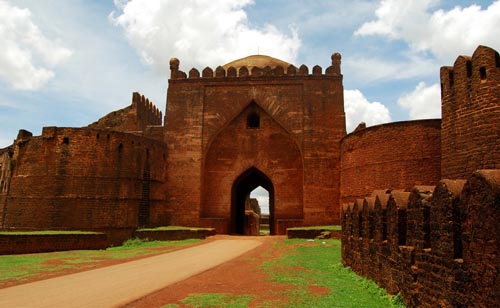Bidar Fort

Information on Bidar Fort (Bidar, Karnataka) - History & Architecture
Bidar fort is situated in the district of Bidar, northern plateau of Karnataka, in India. The Fort was formerly built in 8th century furthermore strengthened and reconstructed in 1428 by Sultan Ahmad Shah Bahamani. The Bidar fort shows off with a dominating existence in the landscape of Bidar. Present within this entwined fort is the magnificent town scattered with degeneration shell of the bastions and the entrance. There is also royal bath, kitchen, and hall for the audience, and the exhibition area.
Bidar Fort Architecture
The Fort is constructed on the periphery of the plateau. It has a disorganized quadrangular layout figure, which is 0.75 miles in length and 0.5 miles in breath. The peripheral length of the walls measured is 4,500 yards. The ramparts, bastions, gates and barbicans of Bidar are however, well conserved and well thought-out as, some of the most fashionable in India. The Fort is bordered by a triple moat.
In the Fort there are seven gates. The main gate present is in Persian style architecture. The 'Gumbad Darwaza' depicts arches with overformal size, and is in Persian technique. Sherza Darwaza of Bidar Fort, is the second doorway for entry, depicts two imagery of tigers is imprinted on its front part. To the belief of Shia, the garland of the tiger is problem-solving of Ali, who was also known as Asadullah-Al Ghalib that guaranteed safeguard to the construction from opponent assault. The remaining gates are the Fateh Gate on the south which holds the style of octagonal towers and also has the drawbridge. The Talghat Gate is in the east, along with the Delhi Gate and the Mandu Gate. The well-known fortress Munda Burj is at the entrance with the guns placed on it.
Bidar Fort History
Bidar Fort is accredited to the Sultan Ala-Ud-Din Bahman Shah. He was the foremost sultan of the Bahmani dynasty and ruled. In 1427 he shifted his principal from Gulbarga to Bidar since he believed that Bidar is a place with healthier climatic circumstances and was also a productive and fruit demeanor area. Before it was believed that the existence of the Fort also traced to the first Muslim incursion of the district in 1322 nevertheless it later came into the supremacy of the Tughlaq dynasty.
Shortly, with the institution of the Bahmani dyanasty, in the year of 1347, Sultan Alla-Ud-Din Bahman Shah Bahmani captured Bidar. Again during the imperative of Ahmad Shah I, Bidar was considered as the capital of Bahmani Kingdom, between the years 1422-1486. During this era, the previous Fort was renovated and attractive mosque, madrasas, garden and palaces came into existence. Mahmmad Gawan , became the Prime Minister of Bidar in 1486 who was a distinguished one in the history of Bidar. Bidar continuously came under the Barid Shahi dynasty. However in 1656 A.D it came under the authority of Mughal monarch, Aurangazeb.
Again in the year of 1724, it became the part of Asaf Jahi Kingdom. Soon it was annexed by the Bijapur Sultanate in 1619 to 1620 but the viceroy of Aurangzeb however conquered it in 1657 and consequently became a part the Mughal kingdom in 1686. The third son of Asaf jah 1, Nawab Said Mohammed Khan Asaf ud Daula, feinted Bidar Fort starting from 1751 to 1762, until in 16 September 1763 his Brother Mir Nizam Ali Khan Asaf Jah 3 enslaved him and killed him in Bidar fort.
Accordingly, Bahmanis feinted over Gulbaraga from 1347 to 1424 and from 1424 till the extermination of the sovereignty and its degeneration into five autonomous and militaristic kingdoms of Bijapur, Golconda, Ahmadnagar, Bidar and Berar. After that the kingdoms come apart. In 1724 Bidar came beneath the regulation of the British.
Bidar Fort Tourism Importance
The architectural beauty and the historical importance entice visitors from world across. It carries unique importance of the era that was once seen and witness by this Bidar Fort, which is even today seen and read by generations and continue to do so.
- Bangalore Monuments
- Bagalkot Monuments
- Belgaum Monuments
- Bellary Monuments
- Bidar Monuments
- Bijapur Monuments
- Chitradurga Monuments
- Coorg Monuments
- Dakshina Kannada Monuments
- Gadag Monuments
- Gulbarga Monuments
- Hassan Monuments
- Mysore Monuments
- Raichur Monuments
- Uttara Kannada Monuments
- Yadgir Monuments
- Andaman Nicobar Monuments
- Andhra Pradesh Monuments
- Assam Monuments
- Bihar Monuments
- Chhattisgarh Monuments
- New Delhi Monuments
- Goa Monuments
- Gujarat Monuments
- Haryana Monuments
- Himachal Pradesh Monuments
- Jammu and Kashmir Monuments
- Karnataka Monuments
- Kerala Monuments
- Madhya Pradesh Monuments
- Maharashtra Monuments
- Odisha Monuments
- Punjab Monuments
- Rajasthan Monuments
- Tamil Nadu Monuments
- Telangana Monuments
- Uttar Pradesh Monuments
- West Bengal Monuments